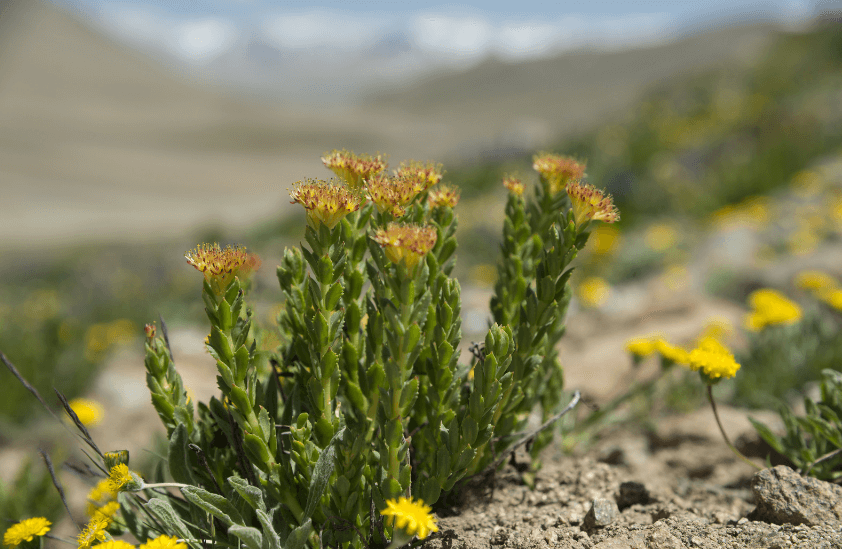
Rhodiola
Share

Common Name Golden Root,Rose Root,Arctic Root,King's Crown
Family Name Crassulaceae
Parts Used Roots
Herbal Actions Adaptogenic, Antidepressant, Antifatigue, Neuroprotective, Cardioprotective
Health Benefits Stress Reduction, Mental Performance Enhancement, Physical Endurance Improvement
What are the Benefits of Rhodiola?
Rhodiola has been revered for centuries across Northern Europe and Asia, particularly in traditional medicine systems like Siberian and Scandinavian herbal practices, as a powerful adaptogen that enhances both mental and physical vitality.* Energetically, this herb is considered to strengthen yang energy, with a slightly bitter taste and a cooling effect when consumed. It is a cornerstone in herbal medicine, commonly used to improve life quality and increase longevity.
Packed with active compounds like rosavins and salidroside, Rhodiola serves as a potent antioxidant that significantly boosts overall health by enhancing the body’s stress response and immune system.* Aptly termed as a natural “performance enhancer,” this robust herb helps in reducing fatigue, enhancing mental clarity, and improving endurance. Its remarkable adaptogenic qualities make it a popular choice not just in traditional medicinal formulas but also in modern dietary supplements aimed at supporting busy, stressful lifestyles. This widespread use underscores its value in enhancing daily function and resilience, making Rhodiola a prized herb in various health and wellness communities.
Historical Use of Rhodiola
Rhodiola, particularly known as Rhodiola rosea, has held a prominent place in the traditional practices of various cultures across Europe and Asia, especially within indigenous communities of cold climates like Siberia and Scandinavia. Historically, Rhodiola was considered a powerful herb with spiritual significance, often used by ancient healers and shamans to enhance physical strength and mental clarity.
According to historical records and folklore, Rhodiola was believed to contain spirits that could help warriors in battle, offering them the vigor and endurance needed for long campaigns. It was also used in rituals aimed at improving stamina and longevity, reflecting its status as a symbol of resilience and vitality.
In these indigenous communities, Rhodiola was not merely a medicinal herb but also an integral part of spiritual and ceremonial life. It was commonly included in rituals to promote mental sharpness and physical health, preparing individuals to face harsh climates and challenging tasks. The root of Rhodiola, often referred to as the "golden root," was highly valued for its ability to reduce fatigue and counteract the stresses of living in extreme environments.
Furthermore, Rhodiola was sometimes used in traditional arts and crafts, where its rich, golden roots were incorporated into decorative objects that symbolized health and good fortune. These historical uses underscore Rhodiola's importance not only for its health benefits but also as a cultural and spiritual enhancer, deeply woven into the fabric of community life and traditions.
Botanical Description & Habitat
Rhodiola rosea, commonly referred to as golden root or rose root, is a perennial flowering plant in the Crassulaceae family. It typically grows to 5–35 cm in height and has several stems growing from a short, scaly rootstock. The stems are thick, leafy, and often tinged with red.
The leaves of Rhodiola are fleshy and grow alternately or in a spiral on the stem; they are oblong to elliptic in shape, with a smooth texture. During the flowering period, which occurs from late spring to early summer, Rhodiola produces small, yellow to greenish or reddish flowers. These flowers are unisexual and sometimes dioecious (having male and female flowers on separate plants), which is relatively rare among the flowering plants.
The plant is known for its distinctive rose-like aroma that emanates from its roots and stems when they are freshly cut, giving it the name "rose root."
Rhodiola rosea is native to the Arctic and mountainous regions in Europe and Asia, thriving in cold climates across the Northern Hemisphere. It is typically found growing in wild and rocky areas, often on sea cliffs, or at high altitudes in mountains. Rhodiola prefers well-drained soil that is sandy or gravely, and despite its rugged habitats, it can also be found in moist, grassy environments.
This adaptogen is well adapted to its harsh environments, exhibiting remarkable resilience by thriving in thin soil and withstanding cold temperatures with minimal shelter. Rhodiola's ability to survive in such challenging conditions is partially why it's been so highly regarded in traditional medicine systems, symbolizing strength and endurance.
